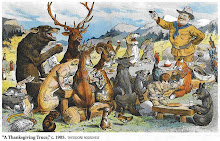Massive Aspen Die-Off on the Wane
Wetter, cooler weather seems to have halted the loss of one of the West's most iconic trees. What's the lesson? The effects of climate change are not simple, nor are the questions about how, or if, to react.By David Frey, 10-06-10
Things are looking up for the iconic tree of the West, though. Recent research shows sudden aspen decline is on the wane. Some areas where the trees have died, though, may never see aspens again. And researchers say the death of these aspens may offer a glimpse of the West as the climate warms.
Drought seems to have caused the massive die-off, and wetter, cooler weather seems to have halted its spread, said researchers with the Forest Service and Colorado State University who have been studying the loss of aspens. The areas where they died closely mirrored Forest Service climate change models.
"We can't say that it is due to climate change, but we can say it's consistent with the predictions or projections of climate change," said Jim Worrall, forest pathologist for the Forest Service based in Gunnison, Colo.. "This drought that incited this is the type of drought that occurs more frequently due to climate change. In fact, it's called a climate change-type drought because it's not only dry but warm."
Sudden aspen decline is believed to have wiped out more than half a million acres in Colorado, about 17 percent of the aspen acreage in the state. The damage was seen mostly on the Western Slope, where aspens are more prevalent. Similar events have happened in southern Utah, northern Arizona, Wyoming and Canada. The phenomenon largely affected older aspen trees, which are weaker and more susceptible to insects and disease. In many cases, the damage was so severe that even the roots were killed, meaning new suckers could not grow out of them, the primary way aspens regenerate.
That probably means that in many areas, particularly low-altitude areas, that used to have aspens won't see them again in the long-term, Worrall said. That could have an impact on wildlife that rely aspens for food.
"Some of these smaller patches are clearly gone," Worrall said. "You can find these small stands of aspen surrounded by sagebrush and no sucker coming up at all."
Researchers believe the die-off was prompted by the severe drought in the beginning of the millennium, particularly in 2002, the driest year on record in Colorado for centuries.
"It's all about mature aspen forests dying all at once," said Wayne Sheppard, a former Forest Service scientist working on a sudden aspen decline research project for Colorado State University.
"The natural conclusion here is, this is probably a climate change thing, triggered by this extreme drought," he said. "You have to understand that climate change doesn't happen on a nice, clean line. It dances in fits and starts. What we see here may be the first scrimmage in a change that will ultimately proceed."
About 80 percent of the acres affected by sudden aspen decline corresponded with Forest Service modeling that predicted the disappearance of aspens due to global warming in the first part of this century. Those models show aspens disappearing from lower altitudes and south-facing slopes.
"The clear lesson about climate change is, this may be one of the first major impacts of it," Worrall said. "That's something for society to consider. How far do we want to let this go before we react to it?"
Sheppard is studying ways to try to limit the impact on aspen stands, essentially killing the trees to save them. He found that by cutting the trees before they are affected by sudden aspen decline, they produce suckers that will survive.
"It appears that it works if you can get there soon enough," he said.
The problem is that many of the region's aspens are old, Sheppard said. Quick to take root after a fire, aspens came to dominate much of the landscape after mining fires and settlements in the 19th century.
Kebler Pass, near Crested Butte, has become one of the state's premier spots for fall leaf peepers looking for golden aspens, but historic photos show it was filled with conifers in the 1890s. Those conifers are largely gone now.
"One lesson from that is age diversity is a good thing," Worrall said. "It builds resilience and a kind of insurance against events like this. If the predictions from climate change are true, we can expect to see a recurrence of this event in the future and probably more serious."








No comments:
Post a Comment